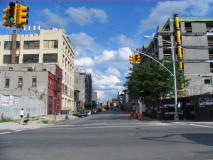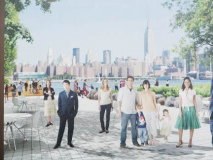Metropolitan
Forgive the blur on the image above: it was blown up from a smaller picture I obtained in 2005 on a previous walk. This is Metropolitan Avenue looking east. Some structures in the photo have been torn down, and new construction has appeared elswhere on the street. Metropolitan Avenue runs almost directly east from the East River waterfront to Jamaica Avenue and the Van Wyck Expressway, joining Williamsburg with Ridgewood, Middle Village, Forest Hills, Kew Gardens and Jamaica. Originally operated as a toll road, the Williamsburg and Jamaica Turnpike, from its opening in 1814 through 1872, it was a main farm-to-market and stagecoach route from mid-Queens to Manhattan (I haven’t documented it but a ferry likely ran from here, or perhaps traffic here employed the Grand Street ferry). In Brooklyn, the stretch between the East River and Humboldt Street was called North 2nd Street; it was renamed Met Ave. around the time of Brooklyn’s consolidation into NYC in 1898.
ABOVE: Metropolitan Avenue from Kent, August 2008. New buildings have appeared on the left side of the street, and most notably, new construction has replaced the Old Dutch Mustard factory on the right. It was a Forgotten favorite for many years; the replacement is a rather bland development called 80 Metropolitan. Urbanfoto also took a lok of the interior at Dutch Mustard before the demolition as did JustinNYC.
The emblazoned building at the NW corner of 210 Kent and Metropolitan is home to art gallery/concert space Live With Animals.
The building is an art collective called “Monster Island.”
Live With Animals is one of the partners in the collective, as is the Secret Project Robot gallery and Kayrock Screenprinting.
Here is a look at some of the installations and performances.
Near the waterfront on Metropolitan Avenue and River street is the Brooklyn branch of Mollusk Surf Shop; the original branch is in San Francisco.
The tiny store caters to purists, with fifteen brands of surfboard, including the retro narrow-nose Dano, as well as classic trunks from Birdwell Beach Britches and legendary surfing DVDs like Morning of the Earth. The hard-to-find shop operates more like a clubhouse than a retail operation: Once a month, the owners throw a block party and project surfing flicks on the giant oil tanks across the street. “I think of this place as a kind of library,” says co-owner Chris Gentile, who will happily explain the environmental virtues of the store’s cork and bamboo boards or update customers on local surf conditions. New York Magazine
Like Schaefer Landing, Northside Piers has been built due to a zoning change in 2005 allowing residential development in this part of Williamsburg. The twin towers (30 and 31 stories) are scheduled for completion in 2009 by mega-developer Toll Brothers.
At right, a rendering of what the developers believe prospective investors and residents will look like.
Railroad Days in North Williamsburg
Few of the new residents at Northside Piers and its neighbor, The Edge, and few present Williamsburgers, for that matter, are aware that they are living on a fairly substantial former railyard.
Until its final edition in 1998, Hagstrom’s hand-drawn Brooklyn map delineated the former Brooklyn Eastern District RR terminal on its map. The compact railyard ran from the waterfront to just past Kent Avenue between North 3rd and North 10th Streets.
Several short freight RR lines have existed in Brooklyn: the NY Cross Harbor Railroad, still in operation at Bush Terminal in Sunset Park; the Jay Street Connecting Railroad in DUMBO; the New York Dock Railway along Furman Street in Brooklyn Heights; and in Williamsburg, the BEDT (so-called because Williamsburg was once known as the Eastern District in the city of Brooklyn). The rail lines connected warehouses in which goods transported from railcars floated across NYC’s bodies of water were stored, then loaded onto trucks to carry them to local storehouses or retail.
No trace today remains of the Brooklyn Eastern District Terminal, which used steam locomotives exclusively from inception in 1875 until 1962. Diesel power was used thereafter until the end of operations July 29, 1983. These photos show BEDT Engines 12, 13, 14, 15 and 16 and are taken from Jay Bendersky’s excellent book Brooklyn’s Waterfron Railways. Some were shot by the longtime NYC railroad photographer Art Huneke of arrts-arrchives.
In 2000 on a bitterly cold winter day, I was staggering around on 1st Avenue in the Bush Terminal area when I spotted BEDT Engine 16 sitting on a Cross Harbor Railroad track. It is now displayed at the Railroad Museum of Long Island at Riverhead.
Kent Avenue and North 5 Street, December 2007
Engine 21, July 29, 1983. Final day of operations, BEDT.
The Edge of Williamsburg
The Edge (which I presume has nothing to do with the permanently toqu’ed U2 lead string plucker) is the third massive residential development under construction on Kent Avenue, just north of Northside Piers. From Douglaston Development’s website:
Over one million square feet to be developed on the Williamsburg Brooklyn waterfront in a mix of mid-rise buildings and high-rise towers. Known as “The Edge,” the project includes Brownfield remediation, master planning, waterfront permitting and construction. 1,000 residential units will be built over 60,000 square feet of retail space and parking for over 1,000 cars. A waterfront esplanade will be built along the river, with a recreational and water taxi pier built into the river from North 6th Street.
In August 2008 there wasn’t much building to show, so I focused on the obnoxious ads catering to what Douglaston Development believes is now Williamsburg’s dominant demographic. Those no-trespassing signs sure look inviting for the casual homebuyer with a spare $1M to toss around. LEFT: a look at what used to be in the area before construction got started.
I have mixed feelings making notations on all these chichi developments on formerly-still-partially-gritty Kent Avenue. As my friends will agree, I have to the point of ad nauseam stated that I never look at the girlie mags like Playboy or Maxim, my philosophy being that these women wouldn’t give me the time of day, why should I give them mine? I suppose there’s a thing called irresistibility, though.
The east side of Kent Avenue remains pretty much as it always has been.
2017: The building on the corner of Kent and North 6th Street, left, was built in 1810; it has been sold and will be knocked down for another condo development.
North 7th Street. The BMT Canarsie Line runs directly underneath; a ventilation shaft can be seen under the smokestacks on the left side of the photo. At the right is the edge of the new, but rough ‘n ready Brooklyn Eastern District Terminal / East River State Park (which I’ll feature on an upcoming Slice). The Canarsie Line is frequently unavailable, at least from Brooklyn to Manhattan, on weekends, as there seems to be perpetual repairs going on with the switching.
LEFT: North 8 condominiums. RIGHT: Ko Rec Type plant, 67 Kent Avenue. Ko Rec Type was a revolutionary product developed in the early 1960ís- a specially formulated correction composition was adhered to a formulated paper. When you made a typo on a manual typewriter, you simply placed the piece of Ko Rec Type over the typo, and corrected it. Very neat, very clean corrections resulted. The company then developed a complete line of correction and imaging products for electronic and self correcting typewriters. The original Ko Rec Type correction paper still sells today. The company has changed with the times, and is now a leading compatible manufacturer of imaging products including ink jet carts, laser toners and fax thermal ribbons. comment, Frank Jump’s fading Ads
North 9th, east of Kent Avenue. I can’t read this. What is it?
ForgottenFan Michael Giaquinto: I may be able to offer some help in connection to the question you posed in your profile of Kent Avenue regarding the building whose name you were not able to read. I believe that it is the “Barouh Building.” The Barouh family owns the Ko-Rec-Type company, and given the its proximity to the Ko-Rec-Type plant, the Barouh Building is likely another Ko-Rec-Type facility.
Ivy-coated veteran at Kent and North 10th. RIGHT: twisted former fire alarm. Many of these were removed from operation by the Giuliani administration because of a high volume of false alarms.
Rendering of Water Taxi on warehouse at North 11th. RIGHT: N.13th Street. A block north at North 14th, Kent Avenue becomes Franklin Street, once part of a wagon route connecting Broolyn and Astoria…
Neziah Bliss, a protege of Robert Fulton, was an early steamboat pioneer and owned companies in Philadelphia and Cincinnati. Settling in Manhattan in 1827, his Novelty Iron Works supplied steamboat engines for area vessels. By 1832 he had acquired acreage on both sides of Newtown Creek, in Greenpoint and what would become the southern edge of Long Island City. Bliss laid out streets in Greenpoint to facilitate his riverside shipbuilding concern and built a turnpike connecting it with Astoria (now Franklin Street in Greenpoint, Vernon Blvd. in Queens); he also instituted ferry service with Manhattan. Though most of Bliss’ activities were in Greenpoint, he is remembered chiefly by Blissville in Queens and by a stop on the Flushing Line subway (#7) that bears his family name: 46th Street was originally known as Bliss Street.
In spite of Williamsburg’s commercial revival beginning in the mid-1990s, retail has yet to arrive on Kent Avenue (even a bodega at Kent and Broadway closed since then) except for Om Sweet Home, “an eco-friendly lifsetyle and home furnishings store.” As of early 2009, it is the one and only retail store on Kent Avenue’s nearly 2.5 mile length.











